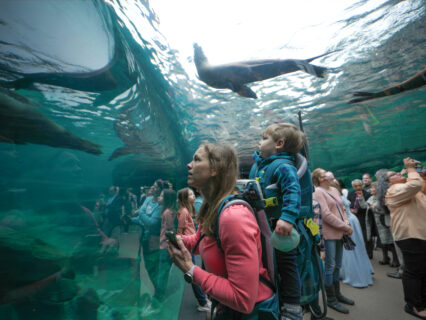
Galapagos Islands at the Houston Zoo: First-of-its-Kind Exhibit Debuts
The Houston Zoo is the first zoo in the world to build a major conservation-focused exhibit based on the Galápagos Islands. Galápagos Islands at the Houston Zoo will open tomorrow, April 7, just in time to bring the Zoo’s centennial anniversary to a close. No other place on our planet better exemplifies the wonders of the unique species, the delicate balance of ecosystems, or the pressing need for conservation more than the Galápagos Islands off the coast of Ecuador. As guests explore the first-of-its-kind exhibit, they become immersed in an environment evoking the archipelago’s unique landscapes and oceanic habitats and highlighting efforts to protect it for the future.
During the opening ceremony today, Houston Zoo president and CEO Lee Ehmke, Mayor Sylvester Turner, and Harris County Judge Lina Hidalgo shared remarks about how Houston’s role and responsibility to keep our shared ocean clean can have a worldwide impact.
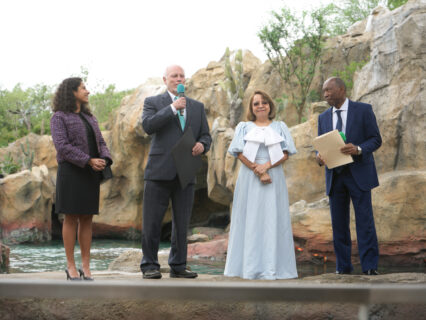
“After years of planning and construction, we can now say that our Houston Zoo is home to the first major Galápagos Islands exhibit in any zoo,” said Ehmke. “With this new exhibit, our more than two million annual guests will learn how our shared ocean connects us to species in the Galápagos, and how our conservation actions here in Houston will lead to healthier oceans worldwide.”
During the ceremony, the General Consul of Ecuador, Alba Coello de Barboza, presented a recognition to the Houston Zoo and expressed gratitude for helping to raise awareness of the importance of wildlife conservation in the Galápagos Islands. Longtime partner organization Charles Darwin Foundation’s executive director Rakan Zahawi traveled from the Islands for the historic event.
Galápagos Islands at the Houston Zoo is the culmination of the $150 million Keeping Our World Wild Centennial Capital campaign that launched in 2018. Since then, the Zoo has created a series of transformative exhibits, new public amenities, and enhanced public spaces. These projects were completed in a six-year, multi-phase plan across the Zoo’s 55-acre site. With the funds raised from the campaign, the Zoo has opened the Hamill Foundation Black Bear Exhibit (2018), Cypress Circle Café (2018), a renovated orangutan exhibit (2019), and award-winning exhibits Kathrine G. McGovern Texas Wetlands (2019) and South America’s Pantanal (2020). The largest initiative in the campaign, opening April 7, 2023, is the Galápagos Islands.
The isolated Galápagos archipelago, off the coast of Ecuador, is among the most interesting places on Earth. About 97% of the reptiles and land mammals, 80% of the land birds, and more than 30% of the plants found there are endemic, meaning they are found nowhere else and among the world’s most endangered species. Most of the animals in the Galápagos Islands exhibit are closely related species and will serve as ambassadors for their Galápagos cousins.
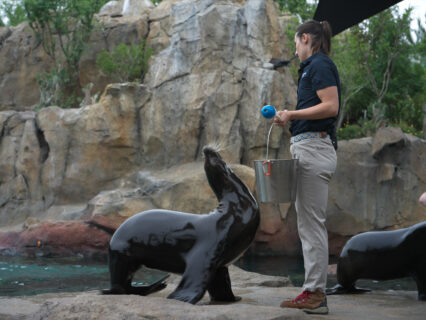
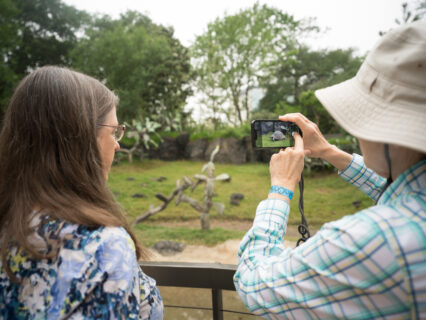

Leaving the underwater tunnel, guests arrive at a theatrically lighted room with beautiful images of sea life juxtaposed with glass cylinders containing three types of plastic waste that threaten ocean wildlife everywhere. But here, the columns filled with plastic bags, straws and bottles represent the amount of waste not entering the environment as a result of the Houston Zoo’s decision to eliminate the use of these products. A mesmerizing wall aquarium of jelly fish (sea nettles) bring home the message that some animals that prey on jellies (like sea turtles) can mistake floating plastic as jellies, with unhappy consequences.
Turning a corner, a 40-foot span of clear acrylic reveals the breathtaking One Ocean aquarium, appearing to extend indefinitely to the open ocean beyond. The unique coral reef structures of the Galápagos reef and a tumble of volcanic boulders provide niches within the 290,000-gallon habitat, where green sea turtles, blacktip reef sharks, bonnethead sharks, cownose stingrays, and other colorful fish swim and take shelter.
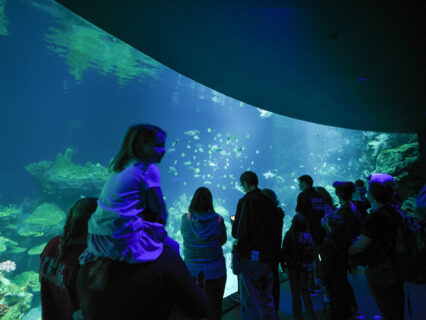
An opening in the lava tunnel wall contains an aquarium featuring giant sea horses (up to 12” in height), colorful sea stars and sea cucumbers. As the lava tunnel floor rises and guests ‘round the corner, playful Humboldt penguins come into view, waddling along a volcanic rock beach, and zooming through the water below, a first-ever for the Houston Zoo. However, they will not have to battle the Houston heat as they will live in a climate-controlled environment where they will be comfortable at a consistent temperature and will be protected from Houston’s mosquitos, which can carry avian malaria.
- The Zoo has provided training and support for Ecology Project International Galápagos, a program that empowers Galapagueño teenagers to be the next generation of Galápagos conservation leaders and the Giant Tortoise Movement Ecology Program and Marine conservation programs in Argentina protecting sea turtles, sea lions, penguins, and other marine wildlife.
- The Houston Zoo provides funding and support for the monitoring of satellite-tagged giant Galápagos tortoises. The data collected from those individuals will allow us to reduce the threats for giant tortoises and contribute to their conservation. The Zoo’s staff have also participated in giant tortoise field studies and have provided local conservation professionals with leadership and tortoises health training in Galápagos for many years.
- The Zoo also participates in and supports sea turtle rescue and rehabilitation on the upper Texas coast with USFWS, NOAA and Texas A&M Galveston. These partners conduct wildlife research, develop education programs and work with local stakeholders to reduce threats to the wild counterparts of the animals in the Galápagos exhibit.
- Houston Zoo staff provide husbandry and veterinary care for stranded and injured sea turtles found on the Texas coast. We have teams that monitor fishing piers and patrol Galveston beaches to retrieve sea turtles in need of medical care. The Houston Zoo has provided sea turtle veterinary health training to partners in Argentina and Texas.
Additional Facts
- 765,000+ gallons of recirculating water in three state-of-the art systems
- A sea lion habitat, with rocky haul outs, deep plunge areas and a 40’ long underwater viewing tunnel for guests
- A 360 sq. ft., 5.5-inch-thick acrylic window into the One Ocean aquarium
- An opportunity to get eye-to-eye with giant Galápagos tortoises
- 25 artificial tree cacti fabricated by Zoo’s in-house artisans
- Nearly 600 individually fabricated corals representing eight different species found in the ocean surrounding the Galápagos Islands, including Pavona Clavus, Pocilloporia Meandrina, Porites Lobata, and Tubastraea
- More than 700 lineal feet of visitor pathway, 640 of it in air-conditioned comfort
- 77,600 square feet of highly detailed lava rock formations sculpted to create a realistic sense of place and dynamic animal habitat
- Over 1,275 trees, shrubs, grasses ana cacti, replicating the arid and forested landscapes of the Galápagos
To learn more about the Houston Zoo, please visit houstonzoo.org.
Source: Houston Zoo


